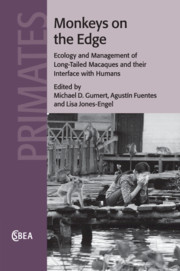Book contents
- Frontmatter
- Contents
- List of contributors
- Foreword
- Preface
- Acknowledgements
- Part I The status and distribution of long-tailed macaques
- Part II The human–macaque interface
- Part III Ethnophoresy of long-tailed macaques
- 8 Macaca fascicularis in Mauritius: Implications for macaque–human interactions and for future research on long-tailed macaques
- 9 The support of conservation programs through the biomedical usage of long-tailed macaques in Mauritius
- 10 Ethnophoresy: The exotic macaques of Ngeaur Island, Republic of Palau
- Part IV Comparisons with rhesus macaques
- Part V Understanding and managing the human–macaque interface
- Index
- References
10 - Ethnophoresy: The exotic macaques of Ngeaur Island, Republic of Palau
from Part III - Ethnophoresy of long-tailed macaques
Published online by Cambridge University Press: 16 May 2011
- Frontmatter
- Contents
- List of contributors
- Foreword
- Preface
- Acknowledgements
- Part I The status and distribution of long-tailed macaques
- Part II The human–macaque interface
- Part III Ethnophoresy of long-tailed macaques
- 8 Macaca fascicularis in Mauritius: Implications for macaque–human interactions and for future research on long-tailed macaques
- 9 The support of conservation programs through the biomedical usage of long-tailed macaques in Mauritius
- 10 Ethnophoresy: The exotic macaques of Ngeaur Island, Republic of Palau
- Part IV Comparisons with rhesus macaques
- Part V Understanding and managing the human–macaque interface
- Index
- References
Summary
The only non-human primate population in Oceania is on the Island of Ngeaur in the Republic of Palau. This population of macaques, M. fascicularis, was the result of ethnophoresy, the dispersal of animals by humans. German colonialists introduced about a half-dozen macaques from Indonesia around 1909. Islanders view these macaques not only as agricultural pests to be hunted, but also, in a limited sense as an increasing part of their natural heritage. Ngeaur is a useful case study for ethnoprimatology to better understand what causes communities to choose conservation, control, or eradication of commensal macaques, which will be important as human and non-human primate interactions continue to increase around the globe. Ethnoprimatologists can also offer counsel to Palauan communities living near macaques by providing guidance on management strategies. Population surveys of the macaques on Ngeaur have estimated the population to be slightly less than 1,000 individuals, which is twice the size of the human population. This chapter discusses how the local communities can control their macaque population by limiting macaque dispersal into the southern part of Ngeaur where taro gardens are located and onto the other islands of Palau. Totally eradicating the macaques may not be necessary nor economically in Palau's best interest. Dispersal management will be a more cost effective approach than eradication efforts, which can be expensive to implement. Macaques could also be used to draw economic gains from tourism, providing a resource to local communities.
- Type
- Chapter
- Information
- Monkeys on the EdgeEcology and Management of Long-Tailed Macaques and their Interface with Humans, pp. 252 - 272Publisher: Cambridge University PressPrint publication year: 2011
References
- 3
- Cited by

